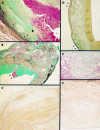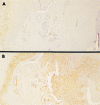Plaque composition in plexogenic and thromboembolic pulmonary hypertension: the critical role of thrombotic material in pultaceous core formation
- PMID: 12117850
- PMCID: PMC1767204
- DOI: 10.1136/heart.88.2.177
Plaque composition in plexogenic and thromboembolic pulmonary hypertension: the critical role of thrombotic material in pultaceous core formation
Abstract
Background: Patients with pulmonary hypertension develop intimal plaques in large pulmonary arteries.
Objective: To test the hypothesis that the composition of such plaques differs depending on whether the aetiology of the disease is thromboembolic or hypertensive.
Design: Chronic thromboembolic and plexogenic pulmonary hypertension (primary and secondary (Eisenmenger syndrome)) were investigated. These are spontaneous human models and were used to examine the independent role of thrombus and hypertension in plaque composition.
Setting: A national tertiary referral centre for lung transplantation and pulmonary thromboendoarterectomy.
Patients: Thirty nine patients with chronic thromboembolic pulmonary hypertension who had undergone thromboendoarterectomy (n = 32) or lung transplantation (n = 7), 28 with plexogenic diseases (nine primary and 19 Eisenmenger), and three with Eisenmenger syndrome complicated by thromboembolic events.
Interventions: The lung and thromboendoarterectomy samples were sectioned, stained with Movat pentachrome, and immunostained with antibodies for fibrin, platelets, inflammatory cells, smooth muscle cells, and erythrocyte membrane glycophorin A.
Main outcome measure: Composition of the plaques affecting large pulmonary arteries.
Results: Two types of intimal lesion were distinguished in chronic thromboembolic pulmonary hypertension: fibrous plaques with angioneogenesis; and core-rich atherosclerotic plaques with pultaceous cores largely consisting of glycophorin immunoreactive material, with cholesterol clefts (61.5%), CD68 positive macrophages (84.6%), T lymphocytes (87%), and calcification (46.1%). The samples from the patients with Eisenmenger syndrome and thromboembolic complications had similar characteristics, whereas those from patients with uncomplicated primary pulmonary hypertension had core-free fibrous plaques, spotted with macrophages and T lymphocytes.
Conclusions: Chronic thromboembolic pulmonary hypertension is associated with atherosclerotic plaques with glycophorin-rich pultaceous cores, and plexogenic pulmonary hypertension with fibrous plaques. Thromboembolic material thus plays a critical role in the formation of pultaceous cores, of which erythrocyte membrane derived glycophorin is a major component.
Figures



Comment in
-
The erythrocyte: a new player in atheromatous core formation.Heart. 2002 Aug;88(2):115-6. doi: 10.1136/heart.88.2.115. Heart. 2002. PMID: 12117825 Free PMC article.
References
-
- Bjornsson J, Edwards WD. Primary pulmonary hypertension: a histopathologic study of 80 cases. Mayo Clin Proc 1985;60:16–25. - PubMed
-
- Wagenvoort CA. Hypertensive pulmonary vascular disease complicating congenital heart disease. A review. Cardiovasc Clin 1973;5:43–60. - PubMed
-
- Wagenwoort CA, Wagenwoort N. Pathology of pulmonary hypertension. New York: John Wiley and Sons, 1977.
-
- Moser KM, Auger WR, Fedullo PF. Chronic major-vessel thromboembolic pulmonary hypertension. Circulation 1990;81:1735–43. - PubMed
Publication types
MeSH terms
LinkOut - more resources
Full Text Sources
Other Literature Sources
Medical
